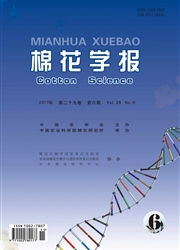

 中文摘要:
中文摘要:
【目的】磷是植物三大必需矿质元素之一,对植物的生长发育至关重要。Pht1家族的磷酸盐转运蛋白在植物磷吸收和转运方面具有重要作用,然而关于该基因的系统研究工作尚很少开展。本研究旨在进行Pht1家族成员全基因组鉴定和表达模式分析。【方法】通过生物信息学的方法对陆地棉Pht1家族成员的基因结构、编码蛋白质的结构、染色体定位、基因复制和表达情况等进行全面分析。【结果】(1)在陆地棉的基因组中共鉴定到17个磷酸盐转运蛋白基因(GhPT),其中A亚组包含8个GhPT,D亚组包含9个GhPT;(2)棉花GhPT蛋白之间序列相似性很高,并均具有12个疏水的跨膜区域;(3)进化分析表明这些GhPT蛋白主要聚为2大组(GroupⅠ和GroupⅡ),位于同一组的GhPT的编码基因大部分具有相似的内含子/外显子分布模式;(4)17个GhPT基因不均匀分布在A亚组和D亚组中的5条染色体上,串联复制和片段复制可能导致GhPT基因在陆地棉中的扩增;(5)表达模式分析表明,GhPT6和GhPT14在根中表达量最高,且同时响应低磷和低钾胁迫诱导并上调表达。【结论】这些结果将有助于深入了解Pht1家族基因的功能及离子信号途径相互作用的分子机制。
 英文摘要:
英文摘要:
[Objective] Phosphorus is one of the three most essential macronutrients required by plants, and is important for plant growth and development. Phosphate (Pi) transporter proteins in the Phtl family play important roles in Pi uptake and translocation in plants. However, few systematic studies have been performed on this topic. In this study, we aimed to identify the Phtl family members in the upland cotton genome and analyze their expression patterns. [Method] The gene structure, chromosomal localization, gene duplication, and expression of Phil family members in upland cotton, as well as the structure of the encoded protein, were analyzed using bioinformatics methods. [Results] (1) A total of 17 GhPT genes were identified in the upland cotton genome, with eight and nine GhPT genes distributed on the A and D subgenomes, respectively. (2) The GhPT protein sequences were highly similar, and included 12 transmembrane regions. (3) The GhPT proteins were divided into Groups I and II based on phylogenetic analyses. Most GhPTgenes within the same group had similar exon and intron organizations. (4) The chromosomal distribution pattern revealed that GhPTgenes were unevenly distributed on five chromosomes of the A and D subgenomes. Segmental and tandem duplications were the major contributors to the increase in the number of GhPT genes in upland cotton. (5) The GhPTexpression patterns revealed that GhPT6 and GhPTI4 were highly expressed in roots. Moreover, the expression levels of these genes were up-regulated under low phosphorus and low potassium conditions. [Conclusion] These results may help to elucidate the functions of GhPTgenes and the molecular mechanisms underlying the cross-talk among ion signals in plants.
 同期刊论文项目
同期刊论文项目
 同项目期刊论文
同项目期刊论文
 期刊信息
期刊信息
